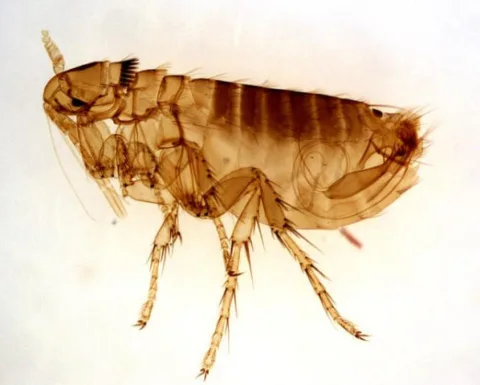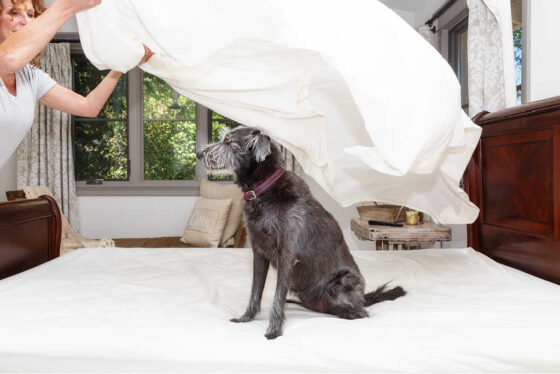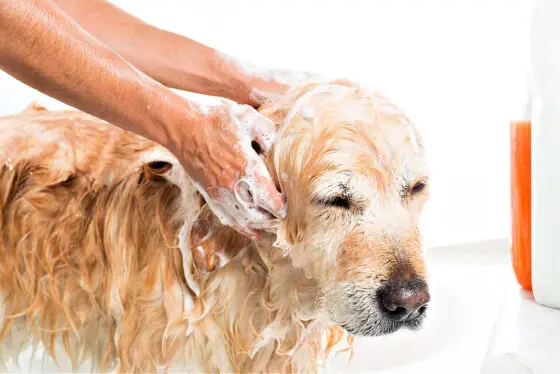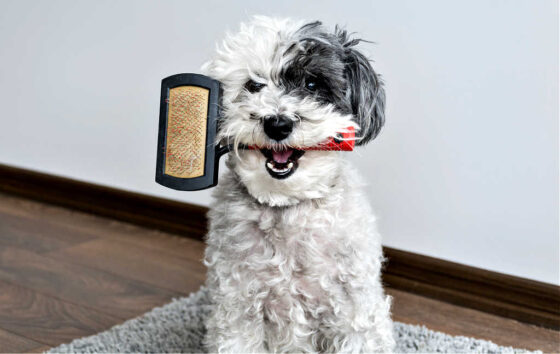If you’ve ever seen a dog suffering from lots of flea bites, then you have an idea of how uncomfortable your dog will become if you don’t treat the fleas on your dog right away.
Plus, if your dog has fleas… then technically you do too! They get into the nooks and crannies inside your house — from the floor boards to the baseboards to the carpet, rugs, and furniture.
And it won’t be long before the fleas are biting on you — and everyone else who comes inside your home!
Trust me on this…
Years ago, I moved into a rental house. It was a large, old house with hardwood floors throughout. I didn’t have any pets. However, the day I moved in I quickly became covered in flea bites! After much discussion with the landlord (and my doctor), it was determined that the entire house was loaded with fleas and had to be fumigated. The fleas were living within the floor boards of the hardwood flooring.
A single female flea can lay 10 to 50 eggs per day and upwards of 2,000 eggs in her lifetime. Thus 1 adult flea can literally lead to an infestation of tens of thousands. Only 1% of the flea population will actually live on your pets which leaves the other 99% lurking in your house and yard in various live stages. The adult female will lay eggs on your pet, who will then act something like a salt shaker, spreading the eggs in the house. The larval stage will emerge within 1 to 10 days. The flea will remain in this stage for 5 to 11 days. This stage is the period of vulnerability where you can kill the juvenile pest. Next the flea will spin a cocoon where they will safely rest for 1 day to 6 months. During this stage, your only hope is to vacuum or wash bedding where the cocoon lies. The flea will remain in the protective cocoon until conditions are right and then emerge to begin the life-cycle all over again. —Dr. Tracy Lord, DVM
The very first time you find a flea on your dog or in your home, it’s time to take action.
In addition to living in your dog’s fur, fleas also live in your furniture, your flooring (hardwood floor creases, carpet, and rugs), and your dog’s bedding.
You don’t have time to mess around with a flea treatment for dogs that isn’t effective.
While there are a number of popular flea products for dogs available that work well, you may want to try a safer, natural alternative first.
Here are the best natural flea home remedies to get rid of fleas on dogs and in your home…
First, How To Determine If Fleas Are The Problem
Using a simple flea comb, a piece of toilet paper, and a drop of water… you can quickly and easily tell if your pet has had any fleas on them recently.
A veterinarian demonstrates how to do this:
If you see “flea dirt” (any black spots in the pet fur that you’ve removed while brushing or combing your dog), then yes… your dog has fleas!
How To Kill Fleas Naturally
You can use any of these 7 methods to get rid of fleas naturally:
#1 – Boric Acid + Vacuum (for outdoor spaces and indoor furnishings)
Boric Acid is a natural insecticide, so it’s one of the best home remedies to get rid of dog fleas. Sprinkle Boric Acid on all surfaces that your dog has been on — inside and outside your home (but not directly on your dog) — including carpet, furniture, and hardwood flooring. The Boric Acid kills fleas and the larvae by dehydrating them and drying them out. Let it set at least overnight… or longer. Then vacuum it up and throw away the bag.
TIP: Boric acid is available in many forms. However, many veterinarians (including Dr. Sherry Weaver, DVM) prefer the Fleabusters brand — because it stays in the house longer. Boric acid is safe and effective, and it can offer flea protection for up to a year or more — since it remains deep in carpet fibers and floor crevices.
#2 – Diatomaceous Earth + Vacuum (for your dog’s coat, indoor furnishings, and outdoor spaces)
Another natural powder that kills fleas is Diatomaceous Earth. This is safe to use directly on your dog and on your furnishings. Simply sprinkle the Diatomaceous Earth along your dog’s spine (when the dog’s coat is completely dry). Massage it in — working your way to the extremities and avoiding the eyes and mouth. Next, sprinkle some Diatomaceous Earth on your carpets, rugs, flooring, and furniture. Brush it in lightly and let it set for about 4 days. Finally, vacuum it up and throw away the bag. (It will gradually wear off your dog.)
TIP: When sprinkling fine powders like Diatomaceous Earth and Boric Acid in confined spaces, it’s best to wear a mask (or a wet bandanna) over your mouth and nose. The reason: even though they are non-toxic, these products are super-fine and when airborne they can dry out your mucus membranes. Also, there are many varieties of Diatomaceous Earth available. Don’t use the kind that’s used in swimming pools. Use 100% natural, organic, food-grade Diatomaceous Earth that is available from health food stores and natural pet sites.
#3 – Nematodes + Watering (for outdoor spaces only)
Nematodes are used outside to control fleas in outdoor areas with grass and soil. Nematodes are bugs (worms) that enjoy hunting and destroying flea larvae and cocoons. They won’t harm anything but fleas and garden parasites — like grubs. You must follow the special watering instructions — in order to prevent the ground from drying out too much for the nematodes to be able to survive and do their work.
TIP: Nematodes tend to work quite well at ridding outdoor spaces of fleas. They have been known to reduce the flea population by 80% in 24 hours. They are most effective in moist, sandy soil away from direct sunlight. The worms don’t survive in the hot sun. Nematodes can be purchased at pet stores, nurseries, and online.
#4 – Salt + Vacuum (for outdoor spaces and indoor furnishings)
Once you’ve discovered that your dog has fleas and you’ve seen them inside your home, vacuum your carpet, throw rugs, dog bedding, and the upholstery on your furniture regularly. The vacuum will suck up the fleas (and eggs) — just remember to empty the vacuum into an outside garbage can each time! Then, to kill the fleas on those surfaces in your home, sprinkle some fine table salt onto your rugs and furniture and leave it for 12 to 48 hours. The salt will adhere to the fleas and larvae and ultimately kill them. After 12 to 48 hours, vacuum up the salt and dead fleas. WARNING: Do not sprinkle salt directly on your dog’s coat — because it’s too harsh for a dog’s skin. And don’t let your dog lick the salt!
TIP: Flea larvae can live up to 1 year without feeding — so make sure to empty your vacuum canister (or vacuum bag) into a larger bag that can be permanently sealed. Then, take it immediately to the outside trash.
#5 – Rosemary Flea Dip & Powder (for your dog’s coat and indoor furnishings)
Combine 2 cups of fresh Rosemary leaves and 2 pints of boiling water. Allow the mixture to boil for 30 minutes. Strain the Rosemary leaves out and discard them. Add 6 pints of warm water to the mixture to make 1 gallon of flea dip. Once it has cooled to a lukewarm temperature, slowly pour the mixture over your dog’s coat (either in the bathtub or outside). Don’t rinse — just let your dog air dry naturally.
TIP: In addition to repelling fleas on dogs, the Rosemary is an anti-inflammatory, so it can help relieve itching and scratching from fleas. Rosemary can be used around the house as well as on your dog to help repel fleas. Grind up rosemary leaves into a powder. Sprinkle in areas your dog sleeps and in areas where he frequently plays around the house.
#6 – Cedar Oil (for your dog’s coat and indoor furnishings)
Cedar Oil (also known as Cedarwood Oil) is an Essential Oil derived from the foliage, wood, and roots of various types of conifers — that is, plants that have cones. Cedarwood Oil has anti-bacterial properties and pesticide effects — which is why it works so well on fleas and ticks. It can be used directly on your dog and on the items within your dog’s environment.
TIP: If your dog is in need of a new dog pillow, consider getting a cedar dog bed. They’re popular for their ability to repel fleas. Don’t want to buy one?… Here’s how to make a cedar dog bed yourself!
#7 – Lemon Spray (for your dog’s coat)
Cut a lemon into 4 sections (including the peel) and place them in a glass jug to make your own homemade flea spray for dogs. Pour boiling water over the lemon wedges, and leave it overnight. The next morning, pour the lemon water into a clean spray bottle and spray your dog’s fur with it. Make sure to get behind your dog’s ears, all around his head (but not near the eyes), under his armpits, and around the base of his tail. Just be careful not to spray on tender parts!
TIP: Lemons contain limonene — a chemical that kills and repels fleas on dogs. It can be used daily on your dog’s skin and coat.
Natural Flea Treatments Must Be Repeated
A natural flea killer isn’t a “once & done” type of treatment.
Home remedies to get rid of fleas need to be repeated — regularly — in order to be effective. Otherwise, the fleas will return!
In homes, fleas mature from egg to adult in 17 to 26 days. However, even after proper treatment, it usually takes 3 to 8 weeks to end an infestation. Vacuum every other day for at least 3 to 8 weeks. After pets and the environment are treated, there shouldn’t be any new eggs. Three weeks after treatment, the fleas in the environment should all have matured into cocooned stages. At this point, vacuuming can be dialed back to 2 to 3 times per week. Still, continued vacuuming is important for triggering pre-emerged adults to exit their cocoons. Return to a normal vacuuming schedule 5 months after the first treatment (unless control wasn’t attained). — Flea Science
In this video, a pest control company reveals the safest methods for getting rid of all 4 stages of flea life forms:
In severe cases, it may be reasonably safe to apply an insecticidal product to kill the existing flea population in the house. —Dr. Jeffrey Levy, DVM
Also, if you’re trying to control fleas from a natural and holistic perspective, then you have to be sure to treat all of the parts involved. Some spaces (like your dog’s indoor bedding, compared to your dog’s space outdoors) may require different forms of treatment than others.
Sometimes, depending on the severity of the flea problem, it may be necessary to resort to a chemical flea product that is commonly used on dogs. If that’s true in your case, then check this list for the safest ingredients to look for in flea products.
IF a pet really needs these chemicals, I’ll use them short term (1 to 3 months as needed.) In my practice, this means most of my patients rarely if ever need flea and tick prevention. (My own dog and cat have never been administered these products.) I prefer to prevent fleas and ticks by treating the yard with beneficial nematodes — they work better than chemicals. (Natural pyrethrums or diatomaceous earth can also be used.) I then recommend an herbal flea and tick shampoo containing citrus oils — the pet is bathed 1 to 2 times weekly for several weeks until the parasites are controlled. Remember that fleas and ticks do not die upon contact with shampoo. Rather, the shampoo works over time. This is why I suggest leaving the shampoo on for at least 20 to 30 minutes before rinsing. Also, pay special attention to the area between the toes and around the ears, since ticks love to hide there! Between bathing, I recommend either an herbal collar (containing an herb such as citronella) or an herbal powder, containing natural pyrethrum made from chrysanthemum flowers. —Dr. Shawn Messonnier, DVM
Remember, natural ways to get rid of fleas take a little longer to work than chemical ways do — because, well, chemicals are clearly stronger. So just be patient and continue to follow the dog flea treatment consistently until your flea problem has been solved.
NOTE: According to the Green Flea & Tick Products Directory, the most effective ingredients to look for in storebought “herbal” or “natural” flea control products are D-limonene, Linalool, Citrus Oils, and these Essential Oils: Tea Tree, Lavender, Cinnamon, Citronella, Clove, Geranium, Bay, Eucalyptus, or Rue. Another helpful ingredient that you will find in some natural flea sprays and flea powders is pyrethrum. It’s a low-toxicity natural pesticide that is made from chrysanthemum flowers.
How To Prevent Fleas On Dogs Naturally
After you’ve killed the fleas inside, outside, and on your dog… it’s also important to do a few additional things to ensure that new fleas don’t find their way onto your dog and into your home.
The following natural flea preventatives are your best bet — after you’ve taken care of the initial flea problem.
To keep fleas at bay, it’s important to do these 2 things regularly:
#1 – Wash your dog’s bedding and clothing frequently. This includes any clothing or bedding of yours that your dog regularly comes in contact with!
#2 – Vacuum all carpet, rugs, and upholstery to suck up any flea eggs and larvae that may have decided to take up residence there.
Vacuuming removes many of the eggs, larvae and pupae developing within the home. Vacuuming also stimulates pre-adult fleas to emerge sooner from their insecticide-resistant cocoons, thus hastening their contact with insecticide residues in the carpet. By raising the nap of the carpet, vacuuming improves the insecticide’s penetration down to the base of the carpet fibers where the developing fleas live. Vacuum thoroughly, especially in areas where pets rest or sleep. Don’t forget to vacuum along edges of rooms and beneath furniture, cushions, beds, and throw rugs. After vacuuming, seal the vacuum bag in a garbage bag and discard it in an outdoor trash container. — University of Kentucky Entomology
In addition, you should do these 3 things semi-regularly:
#1 – Bathe your dog.
Bathing your dog is the quickest way to kill fleas on dogs. In effect, you’re suffocating and drowning them. Your best bet is to use a dog neem shampoo or a dog oatmeal shampoo — especially if your dog has irritated skin from all the scratching. Lather it up real good all over your dog’s coat and leave it on for 15 to 20 minutes. Then, rinse well.
#2 – Brush your dog.
Any dog brush will work in a pinch, but the Furminator tends to get into your dog’s undercoat better than a standard dog brush. And when a dog has fleas, then a flea comb works even better — due to the comb’s teeth being really close together. (A flea comb with a double row of teeth works best of all! For routine combing, I like this dog detangling comb with long and short teeth.) Depending on the severity of the flea problem, you should comb your dog at least once a week — as much as twice a day.
#3 – Use Essential Oils.
You can mix dog-friendly Essential Oils with any other water-based or powder-based flea treatment for dogs that you choose! For example, you may want to add a few drops of flea-repelling Essential Oils to your dog’s shampoo. The safest Essential Oils that repel fleas on dogs and can be used directly on your dog’s coat are: Citronella, Cedar, Rosemary, and Lavender. NOTE: The only downside with using Essential Oils is the fact that they evaporate quickly — so they must be reapplied frequently in order to be effective as a natural flea repellent.
Speaking of using Essential Oils with dogs, you could also:
- Make a homemade flea collar out of a bandanna, a piece of webbing, or a rope collar. Simply rub a few drops of Essential Oil into the material of the DIY flea collar. Keep in mind, flea collars only repel fleas around your dog’s neck. They do very little for the rest of the dog’s body. Most likely, the fleas will just find another spot far enough away from that collar to hang out. Also, most flea collars (especially any that are non-toxic), are only effective for a short time.
- Make a homemade insect repellent for dogs that is a great flea spray. Simply combine 25 drops of any flea-repelling Essential Oils mentioned above with 1 cup of water in a clean spray bottle. Shake to mix thoroughly, then spray directly on your dog, the dog’s bedding, the carpet, furniture, etc.
- Diffuse Essential Oils in your home in scents that repel fleas. I have several diffusers throughout my house, and I alternate the scents I fill each room with! If you don’t want to use a traditional diffuser, there are several less expensive alternatives.
RELATED: How To Use Essential Oils For Aromatherapy
Healthy animals are less attractive to fleas — for reasons that science has yet to determine. Dogs and cats on the kind of ‘junk’ foods that are still widely sold are far more prone to fleas and other parasitic and infectious health problems than those who are on a wholesome, whole-food diet — ideally organically certified and of course nutritionally complete. So many are not, so I strongly advocate the use of the following inexpensive nutrient supplements. I advise giving Brewer’s yeast or nutritional yeast (not Baker’s or bread-making yeast) — about 1 teaspoon per 30 lb body weight mixed into the animal’s food every day, plus 1/2 teaspoon of cinnamon per 30 lb body weight. Begin by giving only a pinch of these nutriceuticals, so the pet will get used to them. Most love them! A teaspoon of Flaxseed oil per 30 lb body weight will also help improve skin and coat condition, (though cats do better on organically certified fish oil). For most breeds of dogs, but not for cats, one garlic clove per 30 lb body weight (chopped up daily and mixed into the food) may also help increases resistance or deterrence to fleas and other opportunists from the insect world. —Dr. Michael Fox, DVM
Like this post? Save it to read again later… or share with others on Pinterest!
I like to help Dog Parents find unique ways to do things that will save time & money — so I write about “outside the box” Dog Tips and Dog Hacks that most wouldn’t think of. I’m a lifelong dog owner — currently have 2 mixed breed Golden Aussies that we found abandoned on the side of the road as puppies. I’ve always trained my own dogs and help friends train theirs, as well. Professionally, I worked at a vet and have several friends who are veterinarians — whom I consult with regularly. (And just because I love animals so much, I also worked at a Zoo for awhile!) I’ve been sharing my best ideas with others by blogging full-time since 1998 (the same year that Google started… and before the days of Facebook and YouTube). My daily motivation is to help first-time dog owners be better prepared from the first day your new puppy enters your home. I like to help dog owners understand what’s ‘normal’ and what you can expect in terms of living with and training your dog — how to get through the ups & downs of potty training, chewing, teaching commands, getting your dog to listen, and everything else that takes place during that hectic first year! When I’m not training, walking, grooming, or making homemade treats for my dogs, you will find me at the corner of Good News & Fun Times as publisher of The Fun Times Guide (32 fun & helpful websites). To date, I’ve written over 600 articles for dog owners on this site! Many of them have upwards of 200K shares.













